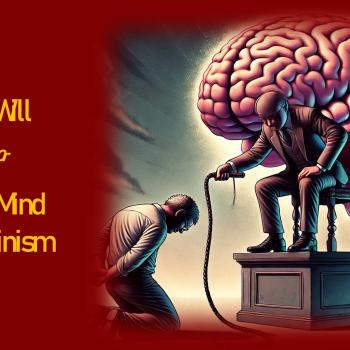How does Jesus save?
Part Two: Jesus as Teacher and as Moral Influence
ST 2102

Jesus as Teacher and Jesus as Moral Influence. Where do these models fit?
In this Patheos series, we ask: how does Jesus save? We need to address this question because evangelicals and progressives along with feminists are all debating the value of Penal Substitution Theory or PST. Because the debate is so vehement, some are even suggesting the jettison of atonement altogether. Yeow!
Union Seminary’s Delores Williams would take Jesus down from the cross.
“I don’t think we need a doctrine of atonement at all. I don’t think we need folks hanging on crosses and blood dripping and weird stuff…We just need to listen to God within” (Williams, 1997, 13).
So, we must ask: just how does Jesus save, anyhow? Here in—how does Jesus save?–Part Two, I will make the point that Penal Substitution Theory is only one theory among many, all of which are biblical. Here is the way I make the list of atonement models. [See Video: Models of Atonement]
- Jesus as teacher of true knowledge
- Jesus as moral influence
- Christus Victor
- 3.a. Jesus as victorious champion
- 3.b. Jesus as liberator
- Satisfaction
- 4.a. Recapitulation Theory
- 4.b. Satisfaction Theory
- 4.c. Penal Substitution Theory
- Happy Exchange
- Jesus as the final scapegoat
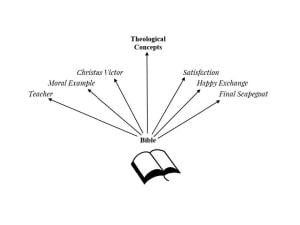
Others such as Stephen Morrison also list atonement models, even if slightly different. Perhaps someone should list the lists.
Now, we turn to soteriology, the locus within systematic theology where atonement is taken up.
What is Soteriology?

“Theology must be relevant and that relevance has everything to do with relationship to wherever there is death or the promise of it,” writes Lutheran theologian Anna Madsen. Death is a promise to each of us. We die each time someone we love dies. Then, it’s our turn. Is God present in these deaths? Yes. So, theology “has to do with soteria. God’s word relates to us” (Madsen 2022, 247) The cross is the symbol of God’s presence in death. And God’s presence is soteriological.
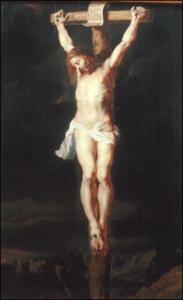
Soteriology is the doctrinal locus that attempts to answer the question: how does Jesus save? That answer takes the form of a theory of atonement.
Has your pastor ever tried the apparently sappy mnemonic that atonement means at-one-ment? Well, it’s actually on point. That’s what it means.
The word, atonement, probably originated in the Anglo-French usage by the Normans after their conquest of the Anglo-Saxons in 1066: etre a un, meaning “to agree.” Was it Sir Thomas More (1478–1535) or was it William Tyndale (1494-1536) who first used the term in its modern form? Regardless, in More’s The History of Richard III it means reconciliation, especially between disputing political powers. Anglican Bibles of the sixteenth and seventeenth centuries began using atonement to translate the Hebrew ּכפד (kaphar) and the Greek ἱλασµόϛ and καταλαγή, meaning expiation and reconciliation.
In systematic theology, the term, atonement, has come to refer to the state of reconciliation between our gracious God and the estranged human race, the state of at-one-ment, accomplished through the work of the savior, Jesus Christ (Peters, God–The World’s Future, Chapter 7).
Here are the questions that light the fuse on the fireworks: does atonement require the shedding of human blood by a bloodthirsty deity? Does there exist a metaphysical mechanism of sacrifice? Did Jesus’s suffering trigger this sacrificial mechanism, thereby forcing God the Father to forgive? No! Neither the biblical sources nor theological reflection rely on such a sacrificial mechanism. Nor do they describe the atoning deity as bloodthirsty. Let’s mop up the spilled blood and look at six different models or theories of doctrinal interpretation.
Keep in mind that each of these models is founded on scripture combined with theological reflection on scripture. I recommend that we not pit one model against the others, even though it’s worth pointing out differences. Rather, I recommend we think of them all as a collection of symbolic metaphors that celebrate in different ways how “In Christ God was reconciling the world to himself ” (2 Cor. 5:19a).
1. Jesus as teacher of true knowledge
How does Jesus save? Does he save us by teaching us the truth? Jesus teaches knowledge of God’s love, graciousness, and saving desire. Is this the truth? If so, does this imply that it is God the Father, not God the Son, who is the true savior? Does it imply that Jesus only shows us the way to salvation, while we obtain salvation by following this way? Do we end up saving ourselves?

Jesus’ Sermon on the Mount in Matthew 5-7 depicts Jesus as a popular teacher, a profound and even revolutionary teacher. But, Jesus is not simply one teacher among many. Jesus is the teacher of teachers. He even trumps Moses. Matthew 5:21-22: “You have heard that it was said [by Moses in the Ten Commandments] to those of ancient times, ‘You shall not murder’; and ‘whoever murders shall be liable to judgment.’ But I say to you that if you are angry with a brother or sister, you will be liable to judgment…”
This “but” subordinates the teachings of Moses to Jesus, the definitive or final teacher: “I am the way, and the truth, and the life,” says Jesus (John 14:6). To be at one with Jesus is to be at one with the sublime and ultimate reality of God.
The surrounding Hellenistic culture so influenced by philosopher Plato taught that ignorance is the source of all human error. Education, in turn, could deliver us human beings from error, darkness, and sin. This is fundamentally a gnostic (gnosis = knowledge) soteriology. The Jesus-as-true-teacher model relies on “metaphors of divinization, education, recapitulation and exaltation/glorification,” observes Inna Jane Ray (Ray, 1997, 25), who wrote The Atonement Muddle while a student at the Graduate Theological Union.[1]

Symbolized on liturgical vestments as a burning oil lamp representing wisdom, Christ is depicted in the Bible as the “light of the world” (John 8:12) or the psalmist’s “lamp to my feet” (Ps. 119:105). There exists in the Bible a family of related symbols: light-lamp-fire-revelation-truth. Had the Bible known about flashlights and LEDs, I bet they would’ve been included. According to this motif, salvation comes to you and me through believing Jesus’ teachings and following in the way.
The framework of the true teacher model is one of education. This model pictures Jesus as the teacher who shines a light on the path to salvation. Although what Jesus actually taught verbally is valuable, the kind of life be led is more valuable for teaching because it provides a pattern for us to follow.
The unmistakable axis around which the model of the true teacher turns is this: Jesus shows us the way, but salvation does not occur until we follow it.
 Jesus saves us from ignorance by true knowledge
Jesus saves us from ignorance by true knowledge
What would be the anthropology (doctrine of human nature) or hamartiology (doctrine of the fall into sin) that corresponds to the teacher model? If one conceives of the fundamental problem of the human condition in terms of ignorance, as Plato did, then atonement would be achieved through proper knowledge. If we are estranged from God because we live in a terrestrial world of darkness, and in this darkness we overindulge in materiality and war because we cannot see the truth, then we would need a celestial teacher who descends from the realm of light to show us the proper way.
If it is ignorance that separates us from God, then we would need someone who would do such things as present clearly the divine law, provide an example of how we should live, lead us into philosophical truth, or introduce us to mystical insights into transcendental realities. With such assumptions Jesus would be understood as the prophet: the great teacher, the gnostic revealer, who saves us through delivering heavenly knowledge.
When in a future Patheos post we take up Jesus as the Final Scapegoat, we will see again the revelatory component to atonement. According to the scapegoat motif, the cross of Jesus reveals what human nature is, namely, we human beings are liars and killers.
How does Jesus save us from what? Our first model says this: if ignorance is the human problem, then the model of Jesus as teacher of true knowledge coherently maps the road to salvation.
2. Jesus as moral influence
It is one thing for Jesus to tell us the truth. It’s quite another for Jesus to provide an example of how we should live. If Jesus provides a moral example, we find atonement in copying his example. We live a Christ-like or cruciform daily life. As Jesus loved self-sacrificially, so do we. This makes us at-one with Christ.

The example of Jesus’ life is tied to what is commonly called, the moral influence theory of atonement. This theory assumes that humans need to be enabled to engage in sacrificial love. Usually identified with Peter Abelard (1079–1142), this conceptual model presupposes something less than a full-blown doctrine of original sin. In his ethical treatise, Know Thyself, Abelard argues that the human race as a whole does not share in the guilt of Adam’s sin. Through the use of natural reason, we are capable of deciding what is good. We need knowledge of what is good and the strength of resolve to do it. This is what we get through the work of Christ.
Thus, the Jesus-as-example-and-moral-influence theory (frequently shortened to moral influence theory) contends that the atoning significance of Jesus’ death is that it provides us with a compelling example to follow.
Jesus, in persevering through humiliation and the cross, fully embodies God’s own self-sacrificial love. So dramatic are the life and passion of Jesus that they grasp the human imagination and move the heart so that we are empowered to re-embody that same self-sacrificing love in our own lives. Once we have followed suit, reconciliation has taken place.
Here are Abelard’s words: “Now it seems to us that we have been justified by the blood of Christ and reconciled to God in this way: through this singular act of grace made known in us (in that his Son has taken our nature on himself, and persevered in this nature, and taught us by both his word and his example, even to the point of death) he has more fully bound us to himself by love” (Abelard 2007). God’s grace, according to Abelard, is expressed in Jesus as example of God’s love. But, there is more. Jesus provides a compelling example, an influential example. We become overwhelmed with divine love in Jesus so that we commit ourselves to participating in the very love of God in Christ Jesus. The beauty of Jesus’ love sweeps into its train like the children of Hamelin were swept into the music of the Pied Piper.
Immanuel Kant, Moral Influence, and Liberal Protestants
In the liberal Protestant tradition we see variants of the Jesus-as-example-and-moral-influence position in the wake of Immanuel Kant’s (1724-1804) understanding of Jesus as the moral ideal. It is our duty, Kant writes, “to elevate ourselves to this ideal of moral perfection, that is, to this archetype of the moral disposition in all its purity—and for this the idea itself, which reason presents to us for our zealous emulation, can give us power.”
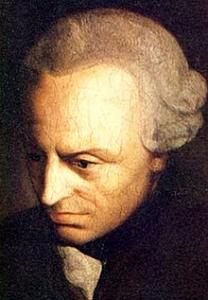
Note, first, how Jesus as the moral example provides the ideal we should emulate and, second, how the very reasonableness of the ideal provides the power to emulate it. Once we voluntarily engage in moral activity that copies Christ then we may “hope to become acceptable to God (and so be saved)” (Kant 1960, 54-55). According to the moral-influence theory, reconciliation comes as the result of our own efforts at following Jesus’ example, efforts that are aided by the compelling power of that very example.
Patheos blogger Matthew Distefano finds weaknesses in the moral influence model. While it has its strengths, both biblically and ethically, it suffers only in that it simply doesn’t say enough about what happened in the life and death of Jesus. In other words, while the theory isn’t necessarily wrong—that is, Jesus Christ is the model of what it means to be “at-one” with the Father (John 5:19–20; 6:38; 8:28; 10:29; 12:49)—it leaves us wanting a more robust explanation as to how Jesus, and most specifically, the cross, saves us.
Comparing Jesus as Teacher and as Moral Influence

What is the difference between the first two models? Both treat Jesus as a teacher, and both rely upon Jesus’ life as an example for us to emulate. The difference lies in what they have Jesus teach. In the first model, Jesus teaches unity with God, perhaps rational or even mystical unity. Some of Jesus’ disciples today take up meditation and spiritual formation so they can emulate Christ.
In the second, Jesus teaches morality. Jesus teaches us how to live the life of love. Many of Jesus’ disciples today take up works of love, acts of charity, service to the poor. According to both models, atonement is accomplished when you and I follow Jesus and achieve what Jesus provided as teacher and example.
Must we follow Jesus’ teachings or Jesus’ example to save ourselves?
Much of the controversy over atonement theory raises again the Reformation question: are we saved by God’s grace or by our own merits? Does the requirement that we have faith constitute just one more work by which we save ourselves?
“Never in Scripture are we told that the atonement itself saves anyone. Scripture knows of no salvation apart from belief” (Allen 2022, 101), writes David L. Allen while critiquing the Calvinist notion of limited atonement. Does belief count against the gratuity of God’s grace?
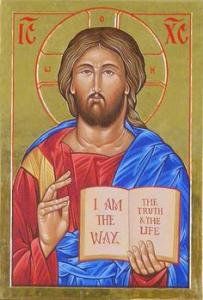
Patheos blogger Adam Erickson ponders the parameters of this issue in reference to the gospel-in-miniature, John 3:16. Recall, eternal life is for the person who believes, who has faith.
“The emphasis on belief troubles many Progressive Christians because it seems like we have to make an intellectual assent to certain Christian dogmas. But what if I told you that there’s a different way to interpret this verse? In the original Greek, the word for ‘belief’ is pistis, which can be translated as ‘belief’, but it can just as easily be translated as ‘trust’. The only question left for us to answer is if we trust and follow Jesus in his radical commitment to God’s nonviolent, universal love. For it’s in God’s nonviolent love where we find eternal life.”
If belief is a human work, why wouldn’t trust similarly be a human work? I have argued frequently elsewhere that what defines our faith as God’s gracious work is not belief or trust. Rather, it’s the very presence of the resurrected Christ in our faith put there by the Holy Spirit (Peters, God—The World’s Future, 119-123).
What we are talking about here is known by the systematic theologian as application (applicatio). On the one hand, the atoning work of Jesus Christ took place as an historical event on Calvary. On the other hand, the efficacy of that saving work is applied, so to speak, to you and me within our faith.[1] Most of the fight today is over the former: just how does Jesus save with his work on Calvary?
What’s Next?
In this post, we have explicated two atonement models, Jesus as teacher of true knowledge and Jesus as moral influence. In our next posts we will turn to the Christus Victor model in two forms, Jesus as victorious champion and Jesus as liberator. In the posts following we will add the additional models on our list of six (Peters, God–The World’s Future: Systematic Theology for a New Era 2015, Chapter 7).
A theological model expands on a biblical metaphor. A metaphor compares what is both like and unlike. For example, to say that Jesus Christ is “the Good Shepherd” (John 10:11-18) must not be taken literally. Jesus was never literally a shepherd. Jesus did not even work part time on weekends tending sheep. Yet, in selected ways, Jesus served his sheep. He even sacrificed his life for his sheep. The task of the theologian is to construct a rational model of Jesus’ atoning work that teases out what we can say literally about the metaphor: Jesus Christ is the Good Shepherd. This method applies to all six theological models of the atonement.
Let me try this again. Each complex of biblical metaphors for atonement provide us with symbols. They reveal God’s saving work. But, they’re not literal. They’re diaphanous. Jesus is both like a teacher and like a moral influence, to be sure. But, we dare not stop there. Jesus as teacher and moral influence provide a window, so to speak, through which we perceive something true about God as Emmanuel, God for us.
Which model is the best? That’s beside the point, according to Orthodox theologian John Whiteford. “As is often the case, the proper Orthodox perspective on this question is one of balance. We should proclaim the whole counsel of God (Acts 20:27), and not just the parts that we find most appealing.”
In brief, all six models belong in our collection of answers to the question: how does Jesus save?
▓

Ted Peters is a Lutheran pastor and emeritus seminary professor, teaching theology and ethics. He is author of Short Prayers and The Cosmic Self. His one volume systematic theology is now in its 3rd edition, God—The World’s Future (Fortress 2015). His book, God in Cosmic History, traces the rise of the Axial religions 2500 years ago. He has undertaken a thorough examination of the sin-and-grace dialectic in two works, Sin: Radical Evil in Soul and Society (Eerdmans 1994) and Sin Boldly! (Fortress 2015). Watch for his forthcoming, The Voice of Christian Public Theology (ATF 2022). See his website: TedsTimelyTake.com.
Ted Peters’ fictional series of espionage thrillers features Leona Foxx, a hybrid woman who is both a spy and a parish pastor.
▓
[1] The Jesus-as-teacher-of-true-knowledge model may be a sister to Gnosticism but not a child. What distinguishes the Christian from the Gnostic is that the former reveres the physical creation. “The Christian doctrines of the incarnation of the divine son and the resurrection of the body flatly contradicted the Gnostic belief that the body and all material reality is inherently evil. Gnostics believed that the savior was not possessed of a material, fleshly body, but somehow flew away from the embodied experience of his crucifixion. Conversely, the suffering and death of Jesus followed by his resurrection proves that God is truly incarnated in the created, fleshly, vulnerable, suffering and dying reality of human beings” (Ray, 1997, 36).[2] According to philosophical theologian William Lane Craig, atonement is “very closely connected to the reformers doctrine of justification. In contrast to Catholic theology, the reformers did not think of justification as God’s infusing into us moral virtue that turns us into morally virtuous people, rather they think of justification as a legal declaration of righteousness. On God’s part, he has credited to our account Christ’s righteousness, and he has credited to Christ our sin and condemnation.”
Bibliography
Abelard, Peter. 2007. “Peter Abelard on the Love of Christ in Redemption.” In The Christian Theology Reader, by ed Alister McGrath, 358-359. Malden MA: Blackwell.
Allen, David. 2022. “A Critique of Limited Atonement.” In Calvinism: A Biblical and Theological Critique, by eds David L Allen and Steve W Lemke, 71-128. Nashville TN: B&H Academic.
Althaus, Paul. 1966. The Theology of Martin Luther. Minneapolis MN: Fortress.
Anselm. 1966. Cur Deus Homo. LaSalle IL: Open Court.
Aulén, Gustaf. 1967. Christus Victor. New York: Macmillan.
Calvin, John. 1535. Institutes of the Christian Religion . Tr. Thomas Norton: https://www.ccel.org/ccel/calvin/institutes.toc.html.
Hultgren, Arland. 1987. Christ and His Benefits: Christology and Redemption in the New Testament. Minneapolis MN: Fortress.
Kant, Immanuel. 1960. Religion within the Limits of Reason Alone. New York: Harper.
Madsen, Anna, 2022. “Suffering and the Theology of the Cross.” Encounters with Luther.
Eds., Kirsi Stjerna and Brooks Shramm. Louisville KY: Westminster John Knox.
Luther, Martin. 1955-1986. LW. Luther’s Works, American Edition, 55 Volumes: St. Louis and Minneapolis: Concordia and Fortress.
—. 2016-2019. The Bondage of the Will (1525) / The Annotated Luther, 6 Volumes. Minneapolis MN: Fortress Press.
Peters, Ted. 2015. God–The World’s Future: Systematic Theology for a New Era. 3rd. Minneapolis MN: Fortress Press.
Ray, Inna Jay, 1997. “The Atonement Muddle.” Journal of Women and Religion 15.
Williams, Delores, 1997. Cited by Inna Jane Ray. “The Atonement Muddle: An historical analysis and clarification of a salvation history.” The Journal of Women and Religion, 15 (1997) 13.




